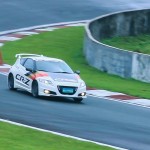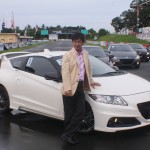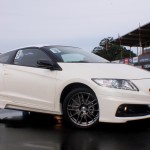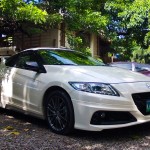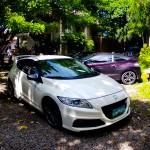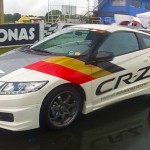Honda CR-Z hybrid on Track: the Future is Now
Warning: Undefined variable $banSource in /var/www/motioncars/wp-content/themes/Motioncars/single.php on line 53
August 10,2013
Warning: Undefined variable $related in /var/www/motioncars/wp-content/themes/Motioncars/functions.php on line 346
 The much-awaited Honda CR-Z was introduced to the public last Monday at the NBC tent in Fort Bonifacio. We previously caught glimpses of this car at last year’s CAMPI motor show at the World Trade Center, together with the other Honda hybrid, the Insight.
The much-awaited Honda CR-Z was introduced to the public last Monday at the NBC tent in Fort Bonifacio. We previously caught glimpses of this car at last year’s CAMPI motor show at the World Trade Center, together with the other Honda hybrid, the Insight.
The day after the launch came the more exciting event: test driving the CR-Z at the Batangas Racing Circuit. We were lucky to be joined by Mr. Norio Tomobe, Large Project Leader for CR-Z, Honda R&D. Tomobe and his team are the very people responsible for the engineering and design of the hybrid CR-Z.
Tomobe recalled that before the start of the CR-Z project, he and his team went to Germany to test and study the Mini Cooper. He said that the Mini is a very well-built car that can perform well on the road. His idea was to build a car that could not just deliver high performance on road, but also be economical for daily use. They came up with a hybrid solution: the CR-Z, which represents the future of automotive technology.
We prepared for driving the hybrid on the rain soaked race track. First we tested the CR-Z’s driving systems around the circuit. The coupe has three driving modes: Econ, Normal, and for maximum excitement, Sports. In Econ mode, the dashboard display features an ambient light that turns green when you are driving efficiently, and blue when your foot is too heavy on the throttle. This ambient light is also a feature in other Honda cars like the new Civic. Engine behavior is rather tame, and the sound subdued, as the car is set for optimal fuel mileage. In Normal mode, the ambient economy light remains but when floored, the engine reacts more quickly, for better acceleration. Sport mode brings the car to its full potential. There’s a sport plus button on the steering wheel to engage the electric motor. Press it and you will feel and hear the motor kick in to assist the gasoline engine. The effect is similar to the nitrous boost on a video game or Formula One’s Kinitec Energy Recovery System.
The CR-Z’s handling around the track was direct and simple: point and shoot driving at its best. The chassis feels well balanced and suited to being driven hard around the track. Tomobe mentioned that the CR-Z’s big advantage is the use of special lightweight metals to reinforce the body.
After a few hot laps we were given a challenge: who can drive the CR-Z most efficiently for three laps and with a maximum time of 12 minutes. I wanted to see just how economically the hybrid drivetrain could perform, with its 1.5-liter iVTEC engine paired with the Integrated Motor Assist, with either manual or CVT transmission. To my surprise, we recorded 20.2 km/liter, and one of my colleagues surpassed that at 21 km/liter.
The CR-Z is a coupe that embodies Honda’s sporty identity, and as a hybrid it combines economy and sport with Honda’s characteristic value. The hybrid Honda is the future, available now to us.
I asked Mr. Tomobe what is next for Honda’s technological development, and he said that hybrid diesel engines will soon be installed in an upcoming model.
Disclaimer: The comments uploaded on this site do not necessarily represent or reflect the views of management and owner of Cebudailynews. We reserve the right to exclude comments that we deem to be inconsistent with our editorial standards.
Warning: include(/var/www/motioncars/inq2014/crowdylanding.php): Failed to open stream: No such file or directory in /var/www/motioncars/wp-content/themes/Motioncars/tpl2018/sidebar.php on line 82
Warning: include(): Failed opening '/var/www/motioncars/inq2014/crowdylanding.php' for inclusion (include_path='.:/usr/share/php') in /var/www/motioncars/wp-content/themes/Motioncars/tpl2018/sidebar.php on line 82




